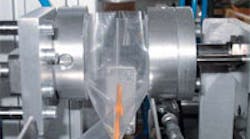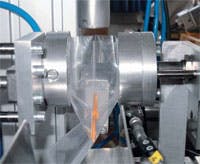By Hansjrg Biefer
Bosch Rexroth AG
Buttikon, Switzerland
Toothbrushes from the brush factory of Ebnat-Kappel AG can be found in nearly every household in western Europe. Ebnat-Kappel also makes other dental products, and uses Bosch Rexroth Non-Contact Transfer (NCT) units to quickly and reliably separate and open plastic bags to facilitate automated packaging of its Interdental Flosser. The NCT units use compressed air to pull on the bags without actually touching them.
Stacked plastic bags can be a real challenge to handle. If they are stacked too loose, they adhere to each other. If they are too tight, they can become crumpled when slid apart. Despite these difficulties, Ebnat-Kappel uses the NCT units to automate this complicated part of the packaging process and allow their Interdental Flosser (dental floss in a container) to be packed into plastic bags.
An NCT unit allows contact-free material handling. It can pick up or pull on an object without any surface contact. The air flow into the NCT unit generates a partial vacuum under the Bernoulli principle fluid physics — the same principle that makes venturi-type vacuum generators possible. The partial vacuum, in turn, creates a lifting force between the NCT and the object, with a small air gap remaining. “We have installed two 60-mm diameter NCT units,” explains Gottfried Kaufmann, purchasing team leader with Ebnat- Kappel. The NCT 60s each produce a lift force of 6.0 N (27 lb) from an input pressure of 5 bar (73 psig).
Step-by-step procedure
Individual Interdental Floss containers are prepared for packing from a conveyor and filling funnel. The empty plastic bags are stacked in the lower part of the system. The first NCT unit sucks the top bag from its right side, then, by way of a swivel arm, it is rotated through 90° and brought into a vertical position.
To open the bag, the second NCT unit sucks the bag from its left side, and the dental products are dropped into the bag. The air supply to this second NCT unit is then switched off, so it releases the left side of the bag, then it withdraws back to its original position. Finally, the first NCT — still holding the bag — swivels to lay the filled bag onto a transport belt, then travels back to its original position.
Problem-free separation
The complete process appears straightforward, but does present a few difficulties, as Kaufmann explains: “In comparison with vacuum technology, an NCT unit does not suck up any dirt and also has no shrinkage effect on the plastic bags. As both these error factors had to be excluded in the Interdental Floss packaging process, we would not have been able to automate this step of the production without the two NCT units.” By using the two NCT units, Ebnat-Kappel achieves operating times of 5 to 10 sec to fill the plastic bags. Kaufmann states that in addition to the optimum handling solution, speed was also of the essence: “We deliver the Interdental Flosser only to order, which means the packaging process has to be completed in the shortest time possible. The error-free separation and opening of the plastic bags naturally plays an important role here.”
On opening the plastic bag with an NCT unit, another NCT unit holds the bag vertically. Here, an air gap ensures non-contact and damage- free handling of the bag.


